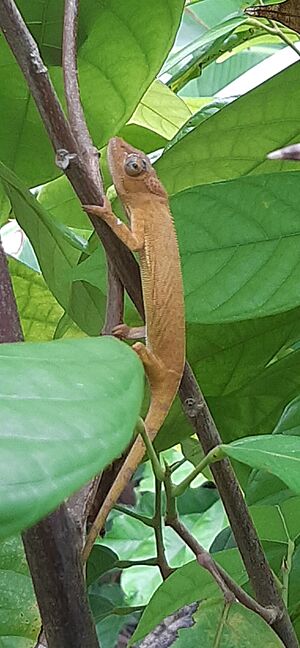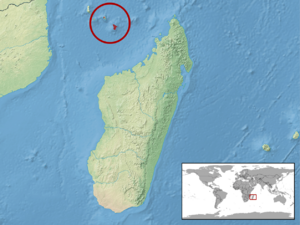Mayotte chameleon facts for kids
Quick facts for kids Mayotte chameleon |
|
|---|---|
 |
|
| Conservation status | |
| Scientific classification | |
| Genus: |
Furcifer
|
| Species: |
polleni
|
 |
|
| Synonyms | |
|
|
The Mayotte chameleon (Furcifer polleni) is a special kind of chameleon that lives only on the island of Mayotte. Mayotte is part of the Comoros Islands in the Indian Ocean. A scientist named Wilhelm Peters first described this chameleon in 1874.
Contents
What's in a Name?
The Mayotte chameleon's scientific name, polleni, honors a Dutch scientist named François Pollen. He was a naturalist, which means he studied nature.
Where the Mayotte Chameleon Lives
The Mayotte chameleon, also known as Furcifer polleni, is found only on the island of Mayotte. This island is quite small, about 376.5 square kilometers (145 square miles). Humans also brought some of these chameleons to the nearby island of Anjouan, where they now live in the town of Hombo.
Chameleon Habitats
These chameleons can live in many different places. They have been found from 27 meters (89 feet) to 459 meters (1,506 feet) above sea level. Scientists have seen them in forests, degraded woodlands, plantations, and even in scrubby dry areas. You might even spot them in towns! However, they don't seem to live in mangrove forests.
Protecting the Mayotte Chameleon
The International Union for Conservation of Nature (IUCN) says the Mayotte chameleon is of Least Concern. This means their population is stable and not currently in danger. It is protected by law in Mayotte. It is also listed in Appendix II of the CITES treaty. CITES helps control the trade of animals and plants to make sure they don't disappear.
How Many Chameleons Are Traded?
Between 2000 and 2010, about 1,562 Mayotte chameleons were sent out of Mayotte. This number did not seem to harm the overall population. Another chameleon species, Furcifer cephalolepis, which lives on Grand Comoro, had many more exported (over 14,000). That large number did affect their wild populations. Scientists believe the Mayotte chameleon population is strong. Even though they live in a small area, they can survive because they adapt well to different environments.
What the Mayotte Chameleon Looks Like
The Mayotte chameleon can be different shades of green. Some are light green, and others are dark green.
How Scientists Classify This Chameleon
Scientists first described this chameleon in 1874. Wilhelm Peters named it Chamaeleon polleni. Later, in 1986, two scientists named Charles Klaver and Wolfgang Böhme moved it to the genus Furcifer. That's why its full scientific name is Furcifer polleni. It is commonly known as the Mayotte chameleon.


